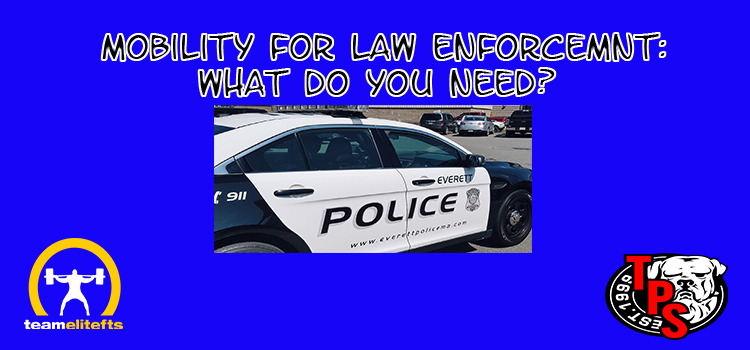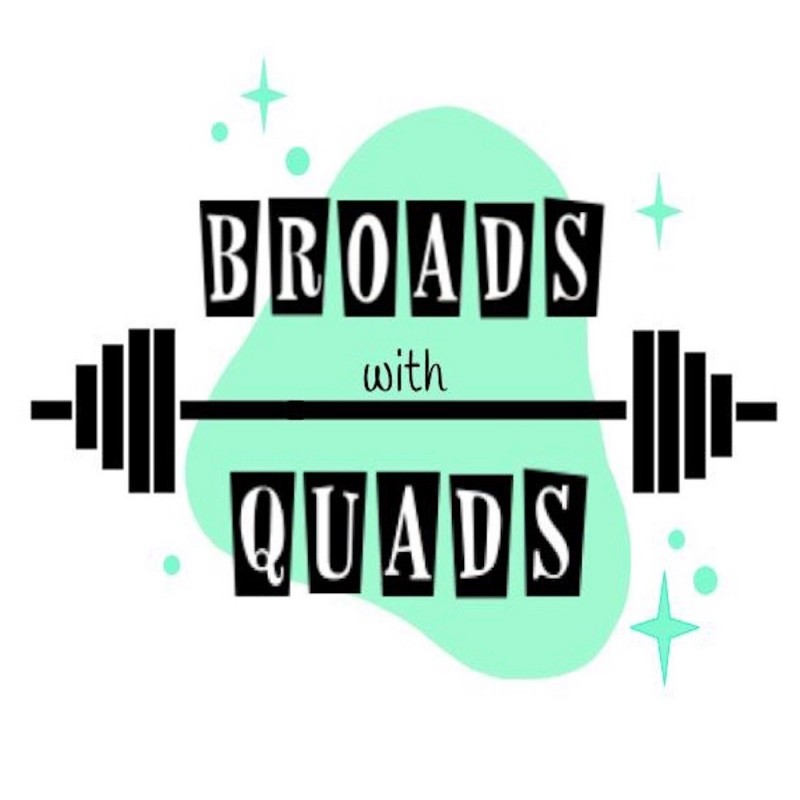
The other day I got this question posted to me on the EliteFTS Q&A:
Murph,
I'm law enforcement and beat up from years in the squad and heavy weight training. I'm really needing some help in the mobility department. I tore my pec some years back and over the years my left shoulder is stiff as hell and my overall mobility and flexibility is crap. Any help or a place to start would be great. There is tons of information out and I've looked at a lot, but its so bad I can't even get in some of the positions to start with. Any good basic starting points would be great.
Thank you.
After reading it, I felt that it required an answer that went beyond the format of the Q&A, and since it seems like a good topic, here is a full answer. Before I go into specifics on the questions, let’s look at what we see with LEO’s in general as far as potential hot spots. LEO’s generally:
- Sit in cars for long periods of time
- Sit at desks for periods of time
- Go from long periods of inactivity/low activity to massive bursts of energy
- Get into situations requiring use of physical force, sometimes these are grossly mismatched
- Get slammed on the ground taking suspects into custody
- Have to stay in uncomfortable positions for longer periods of time
With the above factors in mind (and I’ve discussed these before), let’s go over them and how they affect people.
Sitting in cars is just bad. It is horrible on the lower back and hips.
Sitting at desks is the same as cars, but it adds in poor posture in the upper body when using a PC. This takes a toll on the shoulder girdle area.
Long periods of sitting and inactivity makes you stiff and tight, when you have to jump out of your car and chase someone, apprehend them and possibly wrestle them without a warmup, you increase the risk of injury.
I am not saying that you need to do a warmup to chase a suspect, you cannot. I am saying that it is not optimal.
Think about it.
Would you drive to a track, sit in your car for 45 minutes and then jump out and do some sprints and then wrestle your training partner?
I am hoping you said no, but that is exactly what LEO’s do. Using a required level of force, in accordance with department policy (sorry, my report writing days have stuck with me) against a subject that may be much larger, younger and stronger than you is also less than an optimal situation.
This adds up over time. LEO’s routinely get slammed on the ground in the use of force against a resisting subject. This is not good for you and adds up over time as well.
I can tell you that I could do this in my twenties and go right back to work, but in my thirties, and forties, I was sore for a few days or more after applying reasonable and necessary force in accordance with my training, department policy (there it is again) when a takedown went to the ground.
LEO’s may also need to be in uncomfortable positions, such as crouching behind cover in certain situations.
If you have never experienced what I mean, try crouching against the side of your car and keeping your body out of the line of fire for 30 minutes without moving.
You’ll hate it.
So what kind of Mobility for Law Enforcement do they need?
First, the hips and lower body need a normal range of motion and sitting can impair this.
The hips, quads and hamstrings need to, at least, have normal ranges of motion.
Things like couch stretches, hamstring stretches and Acumobility work (if needed) will be on your list.
Next, you need to strengthen your upper back and trunk.
The upper back gets a beating when you work on a PC or laptop from the hunched over position.
I find that simply addressing this with additional work to strengthen it usually suffices.
A little extra work on Face Pulls, Fat Guy pullups (inverted rows), YTW’s, band pullaparts and similar exercises in addition to your normal back work helps a lot.
Sometimes, additional mobility work may be needed.
Overhead Banded squats are great for this. If you don’t know what they are, Google it with How to Squat - Duffin Movement Series (DMS) and go to about 12:34 in the video.
Sometimes you may need to do a few upper back and shoulder releases using the Acumobility balls.
These videos are available on the Acumobility site.
Using the ShouldeRok is another awesome tool for keeping your shoulders in a normal range of movement.
I am also a big fan of Bench Yoga from Duffin and Kabuki for the upper back/shoulder area.
Strengthening the trunk (not CORE) is always a good idea for everyone, but for LEO’s it is even more important.
I am pretty sure I don’t need to explain why this is important.
Some of the best exercises for strengthening the trunk are:
- Bird Dogs-done the Kabuki Movement Systems way
- Farmers Walks
- 1 Arm Farmers Walks
- GHR Situps
- Planks
- Just about anything done properly on a TRX or Blast Straps
Of course there are many more, but these are all good and scalable, meaning, they can be regressed or progressed depending on your level of strength.
And, let’s not forget RPR (Reflexive Performance Reset). 
I am convinced that the benefits of RPR will become more accepted soon and put into use by the more open minded coaches.
The close minded ones will simply scoff at it and discount it without giving it a chance.
RPR is a game changer and JL has research to prove it. I’ve seen some of it.
For LEO’s, it can make an enormous impact.
There is too much info out there on this for you to look up, so I am not going into what it is, and how it works.
I’ve already written about it. You can read more here.
LEO’s, in my opinion should add in the RPR Wake Up Drills daily.
I was doing them as part of my warmup before training, but have added them in as part of my day in the past 3 months, and it has made a much greater impact. I am much more relaxed.
My pain in the hip is drastically decreased. The reduction in pain did not happen overnight. It got a little less each week, and the more I do the RPR, the lower the level of pain gets.
I also feel that it is transferring to my performance. I have much less pain overall, I am able to move through my exercises much better, sooner with less warmup time.
I am also able to hold better positions throughout each exercise. As an example, my upper back is much tighter on my bench and doesn’t collapse nearly as much under heavier weights.
I feel that RPR has made a big difference as my left lat and shoulder were always the first to go.
After “waking them up” with RPR they feel like they are actually firing properly now.
This allows me to hold better positions in my bench. RPR also has evidence to show that it substantially improves recovery time between sets and keeps you out of the Red Zone.
What do I mean? I am referring to heart rate zones.
The Red Zone is when your heart rate is 170 or above. When you get there, bad shit happens.
- Cognitive Processes deteriorate
- There can be a loss of peripheral vision (tunnel vision)
- Auditory exclusion occurs
- Depth perception is affected
- Loss of fine motor skills occurs
- And much more
For a LEO, this adds up to a bad day.
RPR is proven to decrease this and also to get you back into a better place much faster.
If there is a local seminar on RPR, go to it.
Then apply what you learned.
Daily.
Let’s review Mobility for Law Enforcement: What do you need?
My opinion had changed substantially over the past year on this. I do not think most people need nearly as much as the interweb says, but we all need some.
Especially those who have sustained some form of injury.
Like the person who asked the question.
He had a torn pec and says his shoulder mobility is poor from that, heavy training and from his job duties. I believe him. I’ve been there.
A torn pec and years of heavy training will affect your shoulder mobility, and you WILL need some work where someone without a torn pec may not.
The pec will affect the shoulder, because like the kid’s song says, the ankle bone is connected to the shin bone, and so forth.
A good place for him to start is with RPR Wake Up Drills, followed by some Acumobility work on his pec and upper back. 3-4 minutes of release work done for a few weeks will make a big impact.
Hell, he may not need to do any after that if he is lucky.
He may need to do it longer.
You never know.
Other things LEO’s will want to focus on are, as I said, the hips and quads.
I suggest that you do the amount of mobility work needed to get the job done, and no more. EG:
- RPR Drills-3-4 minutes
- Address your specific area, such as the shoulder/pec/upper back for our person asking the question with the Acumobility balls
- Couch Stretch for 30 seconds x 2
- Banded Overhead Squats as in the Duffin video
- Then go train.
Of course this is not the only answer to the question, just an example.
What I listed should take about 10 minutes.
You do not need 40 minutes of mobility work, just enough to get moving.
As long as you feel that there is some improvement in movement or less pain, your job is done for the day.
This is a marathon, not a sprint, so make small improvements each time and it will add p to big improvements soon.
I hope this helps.
Stay safe.
Some of the ladies in the TPS Method for Powerlifting have started a podcast. It’s called Broads with Quads and it is on iTunes.
It is geared towards the female lifter, but guys will like it too. Check it out.
They’ll appreciate it.
Ask me a question-Be sure and Type to Murph in the header
Find me on Google-search for Total Performance Sports Malden, Mass.
The Best Gym in Boston, Facebook too.
Oh, yeah, follow us on Instagram too. TPSMalden
SHARE THIS!
#bostonsstrongest











Thanks for answering the question and helping me out with a ton of info. I checked into the RPR and Calvin Dietz actually has and RPR clinic here in February I'm thinking attending so I can learn about RPR.
Thanks for reading and best of luck.
Go to Cal's seminar.
Let me know if I can help further.
Murph
Vinceri vel Mori